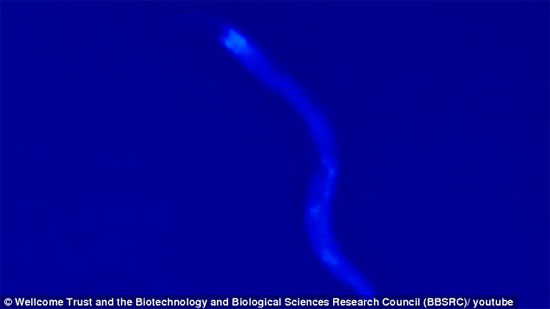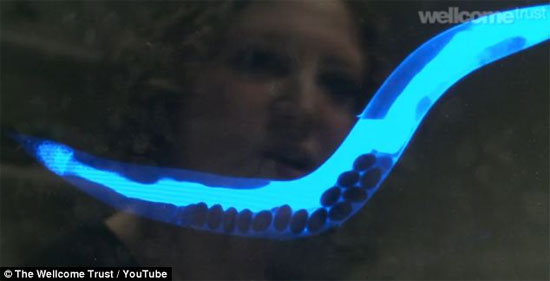The scientific world has captured the image of the god of death.
British scientists have taken a picture of death spreading like a wave across a body of a worm, by studying the blue fluorescence that travels through each cell, until the entire organism died.
Researchers come from the Wellcome Trust Fund and the Biotechnology and Biological Sciences Research Council (BBSRC) for the spread of blue light bands that move throughout the body of a worm like a dead god holding a scythe. rob the victim of the life.

Death like a blue wave of waves spread throughout the worm's body.(Photo: Daily Mail)
When single cells die, they initiate a chemical chain reaction that leads to the breakdown of cellular components and accumulation of molecular debris. The molecular mechanisms of this process have been relatively well understood at the cellular level but we still don't know much about how death spreads throughout the organism until life is completely stopped.
In worms, the spread of death is easily seen under a microscope when a blue fluorescence wave passes through its intestine.
According to a research report published on PLoS Biology, this fluorescence is caused by a series of biochemical reactions that cause cell death called "necrosis" . And its spread throughout the body depends on calcium signaling.
Professor David Gems of the Institute of Aging Health, University College London, head of the study, emphasized: "We have identified the chemical reaction chain of self-destruction, spreading cell death. In worms . We found that when blocking this chain of reactions, we could delay death from stressful conditions, such as infections, although we can't slow down the dying from old age This implies that aging is fatal through a series of parallel processes ".

The mechanism of spreading necrosis in worms is similar to that of mammals.(Photo: Daily Mail)
The mechanisms involved in worms are similar to those occurring in mammals. Therefore, the research team believes that their work could eventually prove to be a useful model to learn about human death and perhaps lead to an increase in our lifespan.
The blue fluorescence source was once thought to be a substance called brown fat, which also emits light of the same color and is related to aging due to its accumulation with the increase in injury. damage in molecules. However, scientists now claim that the "culprit" is another molecule - anthranilic acid. The study also denied the relevance of brown fat.
Professor Gém added: "The findings have raised doubts about the hypothesis that aging is simply a consequence of the accumulation of molecular damage. We need to focus on incidents. Biology happens in the process of aging and death to understand the right way that can interfere with these processes ".
- The clearest picture of the sun flare
- NASA announces unpublished Earth image
- 5 scientific photos won prizes in 2005
- The striking image of NGC 4036 is surprisingly scientific
- The touching moment when animals receive death
- NASA first captured the image of Mars 'full moon'
- Giant death holes around the world
- The final picture of Opportunity robot was captured and it hurt the online community
- Human perception of clinical death
- Pig birds call for death: Reasoning on a scientific basis
- First shot of a DNA image
- Capture the world's largest satellite image missing
 Why do potatoes have eyes?
Why do potatoes have eyes? 'Tragedy' the world's largest carnivorous life: Death becomes ... public toilet
'Tragedy' the world's largest carnivorous life: Death becomes ... public toilet Tomatoes were once considered 'poisonous' for 200 years
Tomatoes were once considered 'poisonous' for 200 years Detecting microscopic parasites on human face
Detecting microscopic parasites on human face